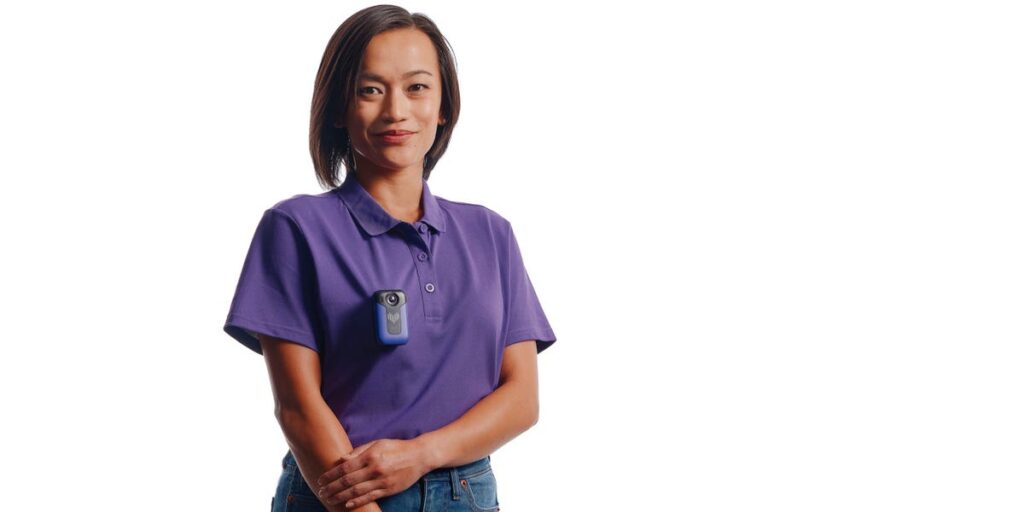Retail workers see a lot of bad behavior while on the job.
From shoplifting to violence to general harassment, the hourly workers who keep stores running smoothly often deal with a higher share of incidents than the average person does.
Some retailers, including Walmart, have responded by testing out the use of police-style body cameras at certain locations as they look for ways to improve worker safety. Others, like Home Depot, continue to invest heavily in curbing shoplifting and other organized retail crime and gathering evidence to prosecute repeat offenders. Off-price retailer TJX has numerous job listings that require employees to “wear a complete company-approved uniform, including a body-worn camera.”
Axon, a leading maker of police body cameras, introduced last year a version of its law enforcement product that it tweaked for retail and healthcare use.
The Arizona-based company reported total revenues of $2.1 billion last year, of which nearly $247 million came from body cameras and accessories.
Now, Axon tells Business Insider it’s launching a lighter and smaller version early next year for frontline workers.
“We know it keeps people safer, we know it limits shrinkage, but now it’s about dialing in the right form factor,” Axon president Josh Isner said.
The Body Workforce Mini is roughly the size and weight of an AirPods Pro case and comes equipped with new communication, AI, and HD video features.
“When you’re on video, just as we’ve seen in public safety, it’s a de-escalator,” Isner said. “These incidents start to just get less intense and less confrontational.”
Front-line workers — from flight attendants enforcing airline mask mandates during the pandemic, to baristas jotting names on cups this month — can be thrust into difficult situations with customers, some of whom may be filming and posting videos of their own on social media.
Motorola, which makes a competing product, surveyed about 1,000 US retail workers last year and found that two-thirds had experienced a shoplifting incident in the past year, and 46% said they had threatening or abusive customer interactions.
Crisis consultant Larry Barton told Loss Prevention Magazine that many retail workers feel that “no one is watching their back” when it comes to dealing with criminals or abusive customers.
Although many retailers have policies against engaging with or otherwise attempting to stop shoplifters, bodycam videos can provide useful information in real time and after the fact.
Isner also said Axon’s new camera can integrate with a store’s existing security system through its video aggregation platform, providing multiple vantage points of an incident, including a first-person perspective.
“You might have the body camera view, the in-car camera view, et cetera, all playing in a time-synced way,” he said, referring to the law enforcement application of the system. “That’s exactly our vision for retail as well.”
Communication and AI tools offer new use cases
The new cameras have two-way communication abilities, so workers can call for help or get important information from a live person or a virtual AI assistant, including translation services for when there is a language barrier, the company said.
Isner said the AI features introduce a whole range of new possibilities for day-to-day retail operations that have little to do with safety or security.
“You might need a quick answer as to where something’s located in the store, or what something costs, or there’s a queue with the register,” he said. “You might start getting those alerts through AI, as opposed to the person coming on the radio and telling you.”
Evidence and cloud services are bigger businesses for Axon than the devices themselves, with more than $808 million in sales last year.
Audio transcripts could also be analyzed to guide management decisions about how to better run the store or train employees, he added.
Indeed, several companies use robot-mounted cameras to scan aisles and update inventory information. Similar data could reasonably be gleaned from a bodycam as a worker restocks the shelves.
With those other applications on the horizon, Isner says Axon’s first focus is on improving workplace safety. However, he said large companies dealing with higher rates of retail crime could see the costs of implementing the system offset by savings from lower theft.
“We really believe we can save these retailers money by deploying these cameras as well as keeping their workforces safer,” he said.
Read the full article here
















